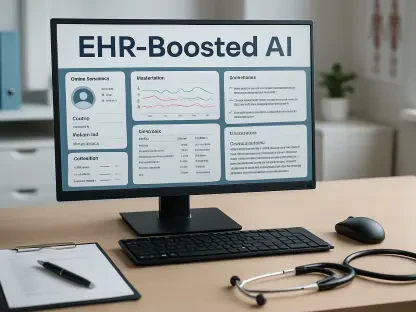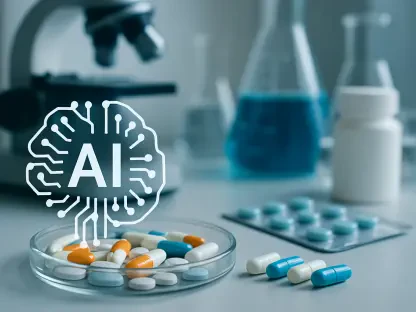In the ever-evolving landscape of healthcare, the mounting pressure on nurses has reached a critical point, with burnout and staffing shortages threatening the stability of the system, while recent data paints a stark picture of over half of U.S. healthcare workers considering new roles due to stress. More than a quarter of nurses are contemplating leaving the profession entirely. Amid this crisis, technology emerges as a potential lifeline, with innovative companies stepping up to address these challenges head-on. One such effort comes from a healthcare technology firm leading a collaborative initiative to revolutionize nursing workflows through artificial intelligence. By focusing on reducing administrative burdens, this movement aims to give nurses more time for patient care, tackling burnout at its core. This article delves into how AI-driven solutions are being tailored to transform clinical environments, offering a glimpse into a future where healthcare providers can prioritize human connection over paperwork.
AI as a Solution for Nursing Challenges
Tackling Administrative Overload with Technology
The administrative workload on nurses has long been a significant contributor to stress and burnout, often pulling them away from the bedside to handle time-consuming tasks like patient assessments and intake forms. A new AI-driven initiative seeks to alleviate this burden by automating much of the documentation process. Spearheaded by a technology company, the solution, tailored specifically for nurses, integrates seamlessly with electronic health records (EHRs) across diverse systems. By streamlining repetitive tasks, the platform allows nurses to focus on direct patient interaction, potentially reducing the mental and physical strain of their roles. Early feedback from healthcare providers suggests that such tools can cut documentation time significantly, freeing up valuable hours in a nurse’s day. This shift not only addresses immediate workload concerns but also aims to improve job satisfaction by enabling nurses to engage more meaningfully with patients, fostering a renewed sense of purpose in their work.
Enhancing Efficiency Through Hands-Free Innovation
Beyond basic documentation, the integration of ambient technology marks a significant leap forward in supporting nursing efficiency. Through partnerships with virtual care companies, AI solutions now offer hands-free documentation capabilities, capturing patient-clinician interactions without the need for manual input. This advancement is particularly impactful during bedside care, where nurses can maintain focus on the patient while the system records critical details in real time. The technology, already influencing over a thousand hospitals nationwide, demonstrates scalability and adaptability to various clinical settings. Such innovations promise to transform how nurses operate, minimizing interruptions and reducing the cognitive load associated with multitasking. By embedding these tools into daily workflows, the initiative ensures that nurses can prioritize empathy and care over clerical duties, potentially curbing the exodus of professionals from the field due to overwhelming stress and understaffing.
Collaborative Efforts Driving Change
Building a Diverse Consortium for Broader Impact
A key strength of this AI initiative lies in the collaborative framework it has established with multiple health systems across the country. This consortium includes a wide range of participants, from large networks using Epic EHRs in South Carolina to rural providers in Missouri leveraging MEDITECH, and others in Ohio working with Oracle Health. The diversity in geographic reach and technological environments ensures that the resulting solutions are versatile and applicable to varied nursing workflows. By incorporating input from such a broad spectrum of healthcare settings, the project addresses unique challenges faced by different facilities, whether urban or rural. This collaborative approach not only enhances the adaptability of the AI tools but also fosters a sense of shared purpose among stakeholders. As more health systems join the effort, the potential for widespread impact grows, setting a foundation for scalable change in how nursing care is delivered and supported.
Industry Perspectives on AI’s Transformative Role
Voices from within the consortium highlight the profound potential of AI to reshape nursing roles for the better. Healthcare leaders have noted that these tools significantly reduce the time spent on administrative tasks, allowing for stronger patient-provider connections. This sentiment reflects a broader industry consensus that AI can be a game-changer in alleviating provider burden while improving care quality. The technology’s ability to generate clinical notes faster—reportedly cutting completion time by over 40%—also translates into tangible benefits like increased revenue per user for health systems. Such outcomes underscore the dual advantage of enhancing workforce well-being and operational efficiency. As the platform continues to evolve, with plans for further integration into bedside documentation, the industry watches closely, recognizing that these advancements could redefine standards of care. The growing interest from other firms in adopting similar AI solutions signals a pivotal shift toward technology-driven healthcare transformation.
Reflecting on Milestones Achieved
Looking back, the strides made through this AI-focused consortium reveal a powerful response to the nursing burnout crisis that has long plagued the healthcare sector. The collaboration between a pioneering technology company and diverse health systems showcases how targeted solutions can lighten administrative loads, allowing nurses to reclaim time for patient care. Partnerships with virtual care innovators further amplify the reach of hands-free documentation, touching countless hospitals and reshaping clinical interactions. Insights from industry leaders echo a shared optimism, affirming that such tools have already begun to mend the frayed edges of a stressed workforce. Moving forward, the emphasis must remain on expanding these initiatives, ensuring more facilities adopt AI to support their staff. Continuous refinement of these technologies, coupled with growing participation in collaborative efforts, stands as the next vital step to sustain momentum and secure a healthier future for nursing professionals.









